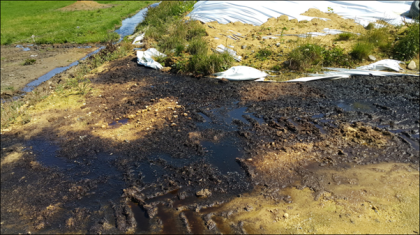
Silage leachate
When grasses and arable crops are cut and stored in a silage pit, fermentation occurs, converting sugars into acids. This acidity prevents the growth of bacteria that would cause the silage to spoil, preserving it for later use. However, this process also produces leachate.
Leachate from silage is extremely toxic to waterways. As a comparison, it is 100 times as strong as raw sewage. For this reason, silage storage areas need to be carefully sited, constructed, and managed to avoid polluting nearby water sources.
Designing a storage area
A good design will help to reduce spoilage from rodents, prevent overland flow of surface or rainwater from entering the storage area, and prevent water pollution by capturing toxic leachate and run-off.
Industry agreed Good Management Practices for Silage.
The following guidelines have been developed by industry bodies in collaboration with councils to ensure silage is managed in a way that is most effective and minimises risks to the environment.
A silage bunker should be positioned:
- At least 45 metres from any farm dairy.
- At least 50 metres from waterways, open drains or dams, and the catchment areas of bores; further away if the land is steep, soils are coarsely textured, or groundwater may enter sensitive waterways.
- Away from gullies or other places where stormwater can flow into the storage area, and land that has a high water table.
- Well away from property boundaries, neighbours, water abstraction points, and critical source areas.
The construction of a silage bunker should include:
- An impermeable/ watertight bunker floor that extends out beyond the bunker walls to prevent loss to groundwater.
- The walls and floor of a silage bunker must be capable of withstanding the hard knocks of tractors and other machinery as well as resisting corrosion from leachate.
- Collection sumps to contain any leachate that is produced and then add this to an existing effluent management system. Ensure storage sumps are big enough for leachate collection of about 3m3/100T silage.
- Spreading leachate onto pasture when grass growth resumes after the cold winter months.
Note: that leachate must be diluted with water or liquid effluent at a ratio of at least 1:10 before applying to pasture.
- Properly covering stacks to keep the oxygen out and prevent rainwater from entering.
When feeding out:
- Locate feed areas away from waterways.
- Distribute feed to minimise soil damage (from farm equipment and animals) and potential surface run-off to waterways, i.e. avoid Critical Source Areas.
Need help?
For more information, talk to your industry partners, or see DairyNZ's guidance on storing grass silage(external link).
Related pages
